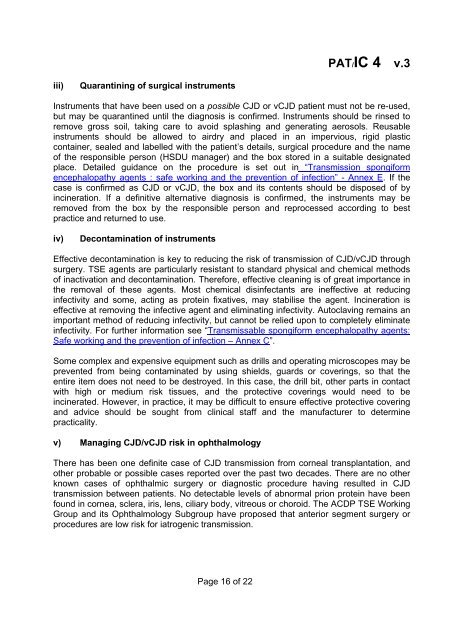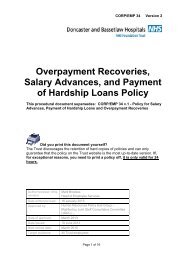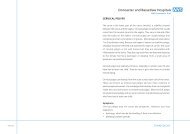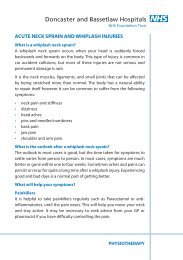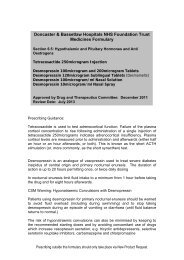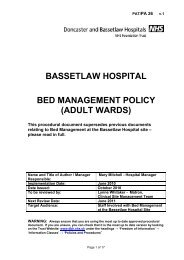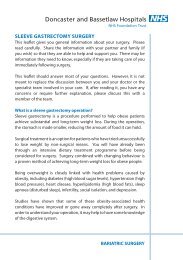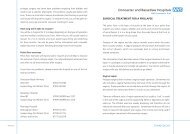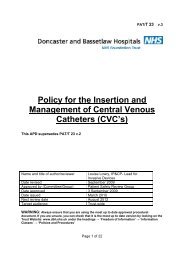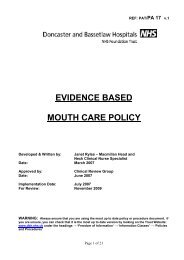VARIANT CREUTZFELDT-JAKOB DISEASE (vCJD) AND ...
VARIANT CREUTZFELDT-JAKOB DISEASE (vCJD) AND ...
VARIANT CREUTZFELDT-JAKOB DISEASE (vCJD) AND ...
Create successful ePaper yourself
Turn your PDF publications into a flip-book with our unique Google optimized e-Paper software.
PAT/IC 4 v.3<br />
iii)<br />
Quarantining of surgical instruments<br />
Instruments that have been used on a possible CJD or <strong>vCJD</strong> patient must not be re-used,<br />
but may be quarantined until the diagnosis is confirmed. Instruments should be rinsed to<br />
remove gross soil, taking care to avoid splashing and generating aerosols. Reusable<br />
instruments should be allowed to airdry and placed in an impervious, rigid plastic<br />
container, sealed and labelled with the patient’s details, surgical procedure and the name<br />
of the responsible person (HSDU manager) and the box stored in a suitable designated<br />
place. Detailed guidance on the procedure is set out in “Transmission spongiform<br />
encephalopathy agents : safe working and the prevention of infection” - Annex E. If the<br />
case is confirmed as CJD or <strong>vCJD</strong>, the box and its contents should be disposed of by<br />
incineration. If a definitive alternative diagnosis is confirmed, the instruments may be<br />
removed from the box by the responsible person and reprocessed according to best<br />
practice and returned to use.<br />
iv)<br />
Decontamination of instruments<br />
Effective decontamination is key to reducing the risk of transmission of CJD/<strong>vCJD</strong> through<br />
surgery. TSE agents are particularly resistant to standard physical and chemical methods<br />
of inactivation and decontamination. Therefore, effective cleaning is of great importance in<br />
the removal of these agents. Most chemical disinfectants are ineffective at reducing<br />
infectivity and some, acting as protein fixatives, may stabilise the agent. Incineration is<br />
effective at removing the infective agent and eliminating infectivity. Autoclaving remains an<br />
important method of reducing infectivity, but cannot be relied upon to completely eliminate<br />
infectivity. For further information see “Transmissable spongiform encephalopathy agents:<br />
Safe working and the prevention of infection – Annex C”.<br />
Some complex and expensive equipment such as drills and operating microscopes may be<br />
prevented from being contaminated by using shields, guards or coverings, so that the<br />
entire item does not need to be destroyed. In this case, the drill bit, other parts in contact<br />
with high or medium risk tissues, and the protective coverings would need to be<br />
incinerated. However, in practice, it may be difficult to ensure effective protective covering<br />
and advice should be sought from clinical staff and the manufacturer to determine<br />
practicality.<br />
v) Managing CJD/<strong>vCJD</strong> risk in ophthalmology<br />
There has been one definite case of CJD transmission from corneal transplantation, and<br />
other probable or possible cases reported over the past two decades. There are no other<br />
known cases of ophthalmic surgery or diagnostic procedure having resulted in CJD<br />
transmission between patients. No detectable levels of abnormal prion protein have been<br />
found in cornea, sclera, iris, lens, ciliary body, vitreous or choroid. The ACDP TSE Working<br />
Group and its Ophthalmology Subgroup have proposed that anterior segment surgery or<br />
procedures are low risk for iatrogenic transmission.<br />
Page 16 of 22


